Design and Development of Guneypark Hospital Management System
VerifiedAdded on 2020/05/16
|108
|25526
|79
Project
AI Summary
This project focuses on designing a new and advanced business process model and system for Guneypark Hastanesi Hatay Hospital. The project aims to address the hospital's current challenges related to privacy, confidentiality, and operational efficiency. The research includes a comprehensive literature review of Health Information Systems (HIS), their technologies, and associated threats, particularly concerning data security. The project employs a prospective research design using secondary data and utilizes methodologies like MOST analysis, Soft Systems Methodology (SSM), SWOT, PESTEL, and the Zachman Framework for system design and analysis. The proposed system aims to improve hospital operations, enhance patient privacy, and streamline business processes through automation and the application of Agile methodologies, ultimately leading to better decision-making, improved patient care, and reduced operational costs. The project includes functional and non-functional requirements, stakeholder responses, and design models to ensure a customized and effective solution for Guneypark Hospital.
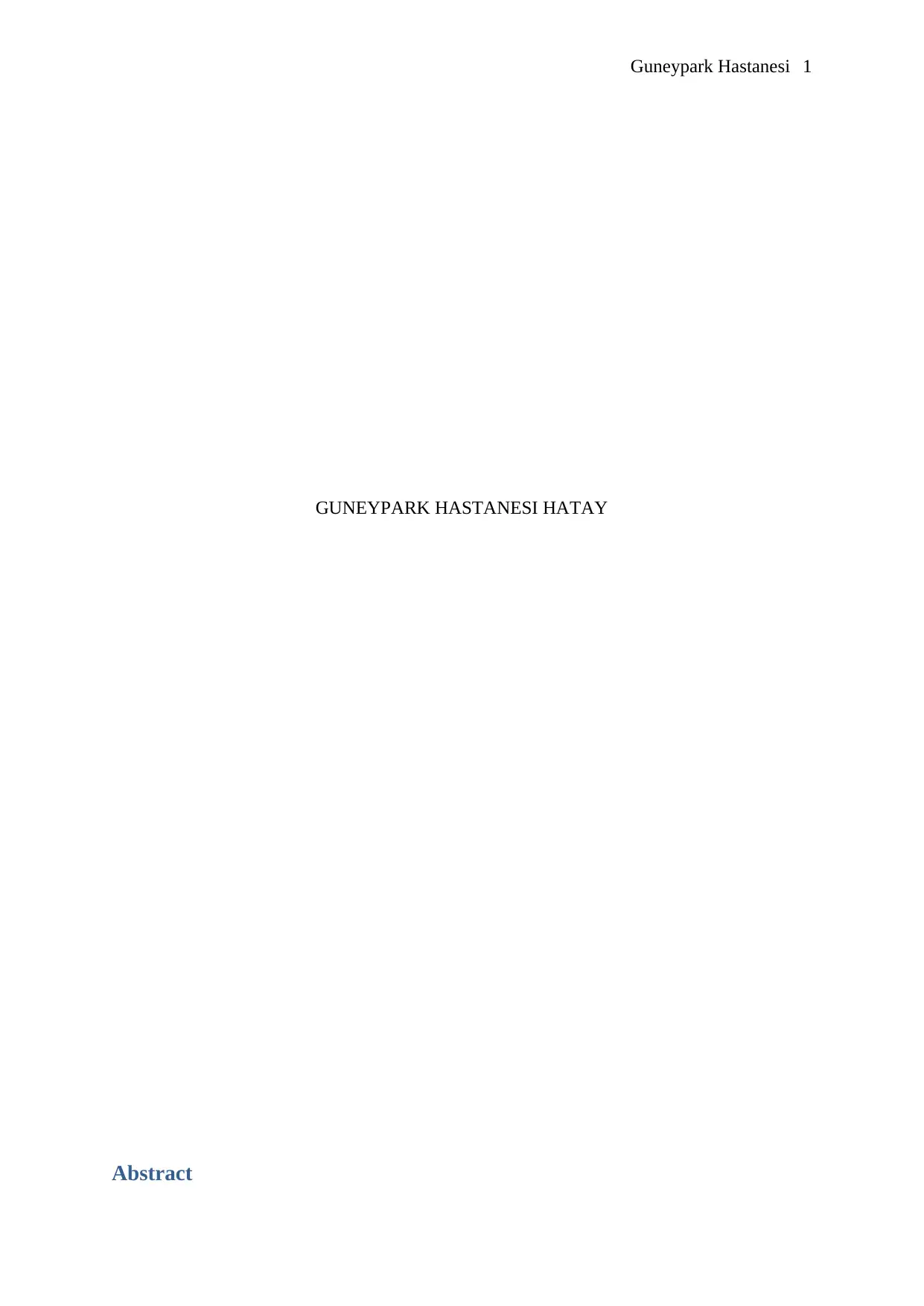
Guneypark Hastanesi 1
GUNEYPARK HASTANESI HATAY
Abstract
GUNEYPARK HASTANESI HATAY
Abstract
Paraphrase This Document
Need a fresh take? Get an instant paraphrase of this document with our AI Paraphraser
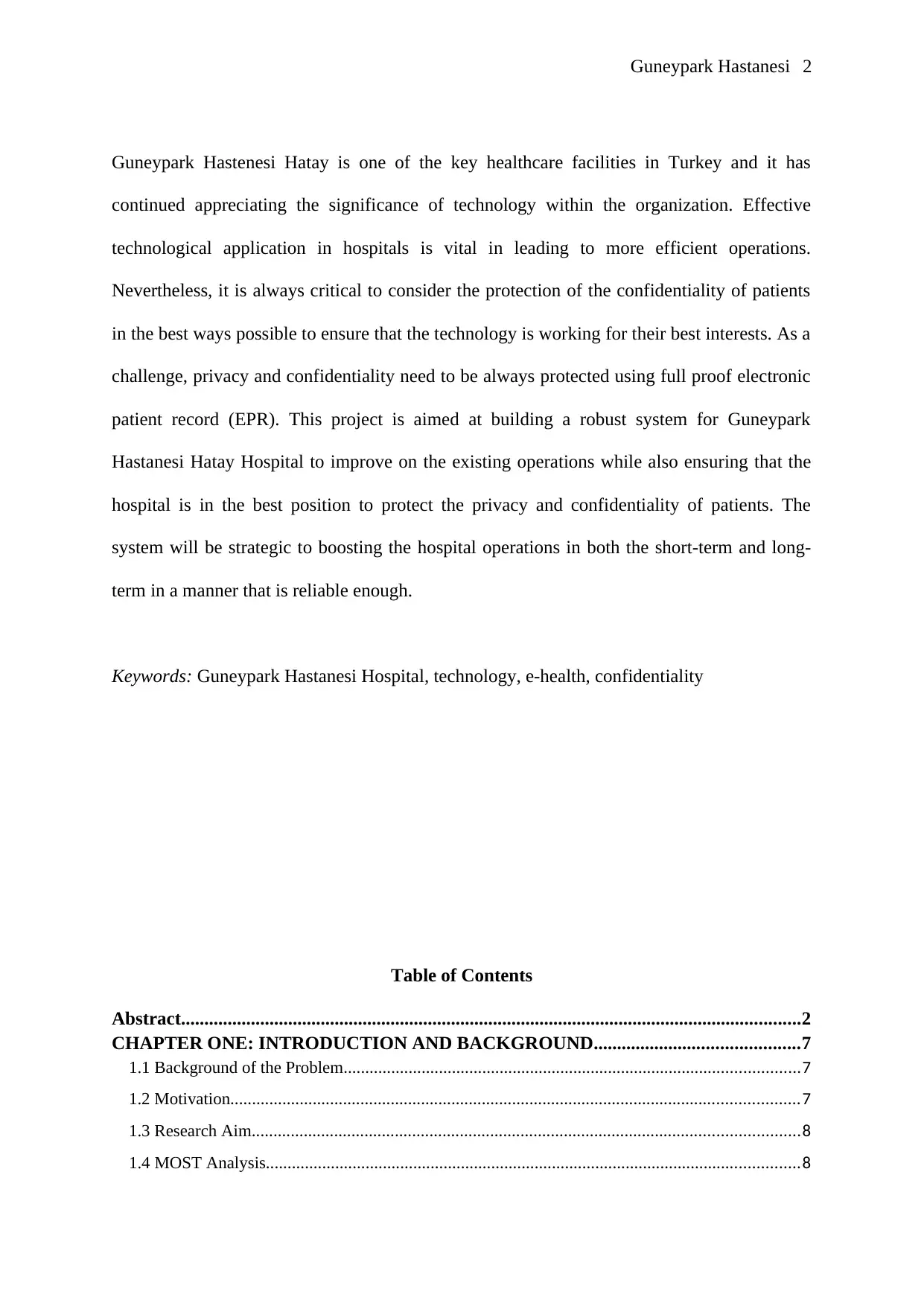
Guneypark Hastanesi 2
Guneypark Hastenesi Hatay is one of the key healthcare facilities in Turkey and it has
continued appreciating the significance of technology within the organization. Effective
technological application in hospitals is vital in leading to more efficient operations.
Nevertheless, it is always critical to consider the protection of the confidentiality of patients
in the best ways possible to ensure that the technology is working for their best interests. As a
challenge, privacy and confidentiality need to be always protected using full proof electronic
patient record (EPR). This project is aimed at building a robust system for Guneypark
Hastanesi Hatay Hospital to improve on the existing operations while also ensuring that the
hospital is in the best position to protect the privacy and confidentiality of patients. The
system will be strategic to boosting the hospital operations in both the short-term and long-
term in a manner that is reliable enough.
Keywords: Guneypark Hastanesi Hospital, technology, e-health, confidentiality
Table of Contents
Abstract.....................................................................................................................................2
CHAPTER ONE: INTRODUCTION AND BACKGROUND............................................7
1.1 Background of the Problem.........................................................................................................7
1.2 Motivation...................................................................................................................................7
1.3 Research Aim..............................................................................................................................8
1.4 MOST Analysis...........................................................................................................................8
Guneypark Hastenesi Hatay is one of the key healthcare facilities in Turkey and it has
continued appreciating the significance of technology within the organization. Effective
technological application in hospitals is vital in leading to more efficient operations.
Nevertheless, it is always critical to consider the protection of the confidentiality of patients
in the best ways possible to ensure that the technology is working for their best interests. As a
challenge, privacy and confidentiality need to be always protected using full proof electronic
patient record (EPR). This project is aimed at building a robust system for Guneypark
Hastanesi Hatay Hospital to improve on the existing operations while also ensuring that the
hospital is in the best position to protect the privacy and confidentiality of patients. The
system will be strategic to boosting the hospital operations in both the short-term and long-
term in a manner that is reliable enough.
Keywords: Guneypark Hastanesi Hospital, technology, e-health, confidentiality
Table of Contents
Abstract.....................................................................................................................................2
CHAPTER ONE: INTRODUCTION AND BACKGROUND............................................7
1.1 Background of the Problem.........................................................................................................7
1.2 Motivation...................................................................................................................................7
1.3 Research Aim..............................................................................................................................8
1.4 MOST Analysis...........................................................................................................................8
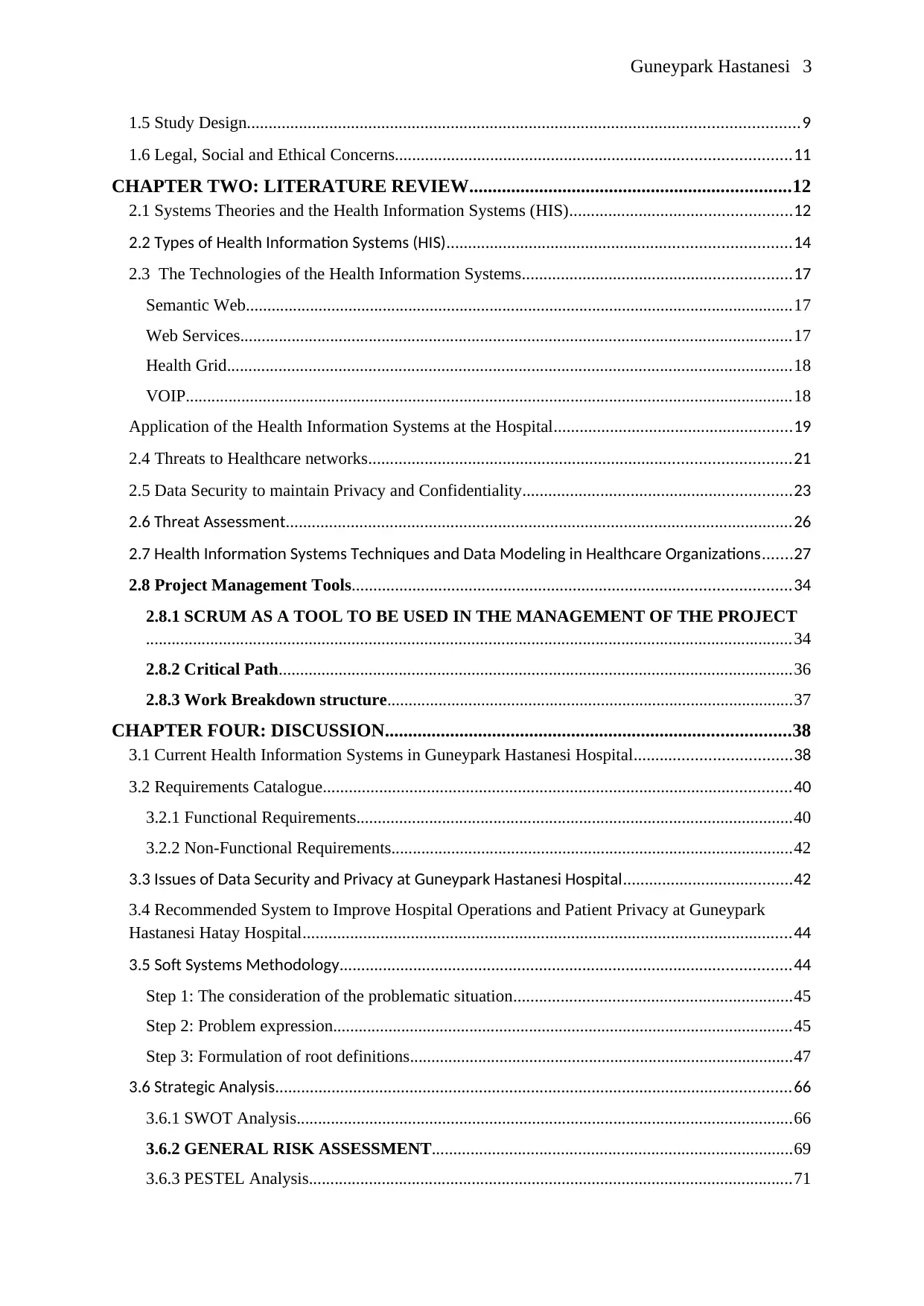
Guneypark Hastanesi 3
1.5 Study Design...............................................................................................................................9
1.6 Legal, Social and Ethical Concerns...........................................................................................11
CHAPTER TWO: LITERATURE REVIEW.....................................................................12
2.1 Systems Theories and the Health Information Systems (HIS)...................................................12
2.2 Types of Health Information Systems (HIS)...............................................................................14
2.3 The Technologies of the Health Information Systems..............................................................17
Semantic Web................................................................................................................................17
Web Services.................................................................................................................................17
Health Grid....................................................................................................................................18
VOIP..............................................................................................................................................18
Application of the Health Information Systems at the Hospital.......................................................19
2.4 Threats to Healthcare networks.................................................................................................21
2.5 Data Security to maintain Privacy and Confidentiality..............................................................23
2.6 Threat Assessment.....................................................................................................................26
2.7 Health Information Systems Techniques and Data Modeling in Healthcare Organizations.......27
2.8 Project Management Tools.....................................................................................................34
2.8.1 SCRUM AS A TOOL TO BE USED IN THE MANAGEMENT OF THE PROJECT
.......................................................................................................................................................34
2.8.2 Critical Path........................................................................................................................36
2.8.3 Work Breakdown structure...............................................................................................37
CHAPTER FOUR: DISCUSSION.......................................................................................38
3.1 Current Health Information Systems in Guneypark Hastanesi Hospital....................................38
3.2 Requirements Catalogue............................................................................................................40
3.2.1 Functional Requirements......................................................................................................40
3.2.2 Non-Functional Requirements..............................................................................................42
3.3 Issues of Data Security and Privacy at Guneypark Hastanesi Hospital.......................................42
3.4 Recommended System to Improve Hospital Operations and Patient Privacy at Guneypark
Hastanesi Hatay Hospital.................................................................................................................44
3.5 Soft Systems Methodology........................................................................................................44
Step 1: The consideration of the problematic situation.................................................................45
Step 2: Problem expression............................................................................................................45
Step 3: Formulation of root definitions..........................................................................................47
3.6 Strategic Analysis.......................................................................................................................66
3.6.1 SWOT Analysis....................................................................................................................66
3.6.2 GENERAL RISK ASSESSMENT....................................................................................69
3.6.3 PESTEL Analysis.................................................................................................................71
1.5 Study Design...............................................................................................................................9
1.6 Legal, Social and Ethical Concerns...........................................................................................11
CHAPTER TWO: LITERATURE REVIEW.....................................................................12
2.1 Systems Theories and the Health Information Systems (HIS)...................................................12
2.2 Types of Health Information Systems (HIS)...............................................................................14
2.3 The Technologies of the Health Information Systems..............................................................17
Semantic Web................................................................................................................................17
Web Services.................................................................................................................................17
Health Grid....................................................................................................................................18
VOIP..............................................................................................................................................18
Application of the Health Information Systems at the Hospital.......................................................19
2.4 Threats to Healthcare networks.................................................................................................21
2.5 Data Security to maintain Privacy and Confidentiality..............................................................23
2.6 Threat Assessment.....................................................................................................................26
2.7 Health Information Systems Techniques and Data Modeling in Healthcare Organizations.......27
2.8 Project Management Tools.....................................................................................................34
2.8.1 SCRUM AS A TOOL TO BE USED IN THE MANAGEMENT OF THE PROJECT
.......................................................................................................................................................34
2.8.2 Critical Path........................................................................................................................36
2.8.3 Work Breakdown structure...............................................................................................37
CHAPTER FOUR: DISCUSSION.......................................................................................38
3.1 Current Health Information Systems in Guneypark Hastanesi Hospital....................................38
3.2 Requirements Catalogue............................................................................................................40
3.2.1 Functional Requirements......................................................................................................40
3.2.2 Non-Functional Requirements..............................................................................................42
3.3 Issues of Data Security and Privacy at Guneypark Hastanesi Hospital.......................................42
3.4 Recommended System to Improve Hospital Operations and Patient Privacy at Guneypark
Hastanesi Hatay Hospital.................................................................................................................44
3.5 Soft Systems Methodology........................................................................................................44
Step 1: The consideration of the problematic situation.................................................................45
Step 2: Problem expression............................................................................................................45
Step 3: Formulation of root definitions..........................................................................................47
3.6 Strategic Analysis.......................................................................................................................66
3.6.1 SWOT Analysis....................................................................................................................66
3.6.2 GENERAL RISK ASSESSMENT....................................................................................69
3.6.3 PESTEL Analysis.................................................................................................................71
⊘ This is a preview!⊘
Do you want full access?
Subscribe today to unlock all pages.

Trusted by 1+ million students worldwide
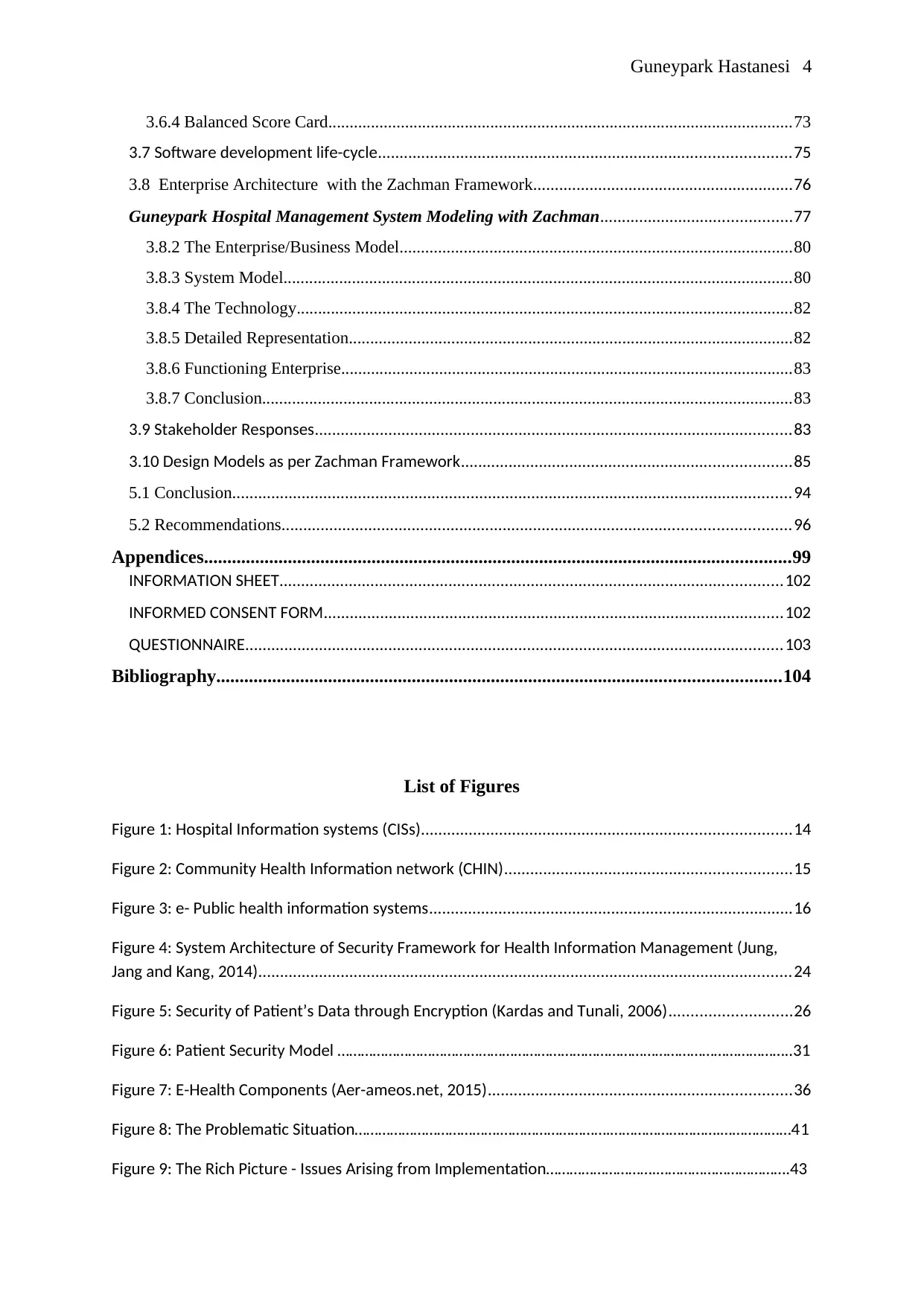
Guneypark Hastanesi 4
3.6.4 Balanced Score Card.............................................................................................................73
3.7 Software development life-cycle...............................................................................................75
3.8 Enterprise Architecture with the Zachman Framework............................................................76
Guneypark Hospital Management System Modeling with Zachman............................................77
3.8.2 The Enterprise/Business Model............................................................................................80
3.8.3 System Model.......................................................................................................................80
3.8.4 The Technology....................................................................................................................82
3.8.5 Detailed Representation........................................................................................................82
3.8.6 Functioning Enterprise..........................................................................................................83
3.8.7 Conclusion............................................................................................................................83
3.9 Stakeholder Responses..............................................................................................................83
3.10 Design Models as per Zachman Framework............................................................................85
5.1 Conclusion.................................................................................................................................94
5.2 Recommendations.....................................................................................................................96
Appendices..............................................................................................................................99
INFORMATION SHEET....................................................................................................................102
INFORMED CONSENT FORM..........................................................................................................102
QUESTIONNAIRE............................................................................................................................103
Bibliography.........................................................................................................................104
List of Figures
Figure 1: Hospital Information systems (CISs).....................................................................................14
Figure 2: Community Health Information network (CHIN)..................................................................15
Figure 3: e- Public health information systems....................................................................................16
Figure 4: System Architecture of Security Framework for Health Information Management (Jung,
Jang and Kang, 2014)...........................................................................................................................24
Figure 5: Security of Patient’s Data through Encryption (Kardas and Tunali, 2006)............................26
Figure 6: Patient Security Model ……………………………………………………………………………………………………..31
Figure 7: E-Health Components (Aer-ameos.net, 2015)......................................................................36
Figure 8: The Problematic Situation……………………………….……………………….……………………….………………41
Figure 9: The Rich Picture - Issues Arising from Implementation……………………….…………………………….43
3.6.4 Balanced Score Card.............................................................................................................73
3.7 Software development life-cycle...............................................................................................75
3.8 Enterprise Architecture with the Zachman Framework............................................................76
Guneypark Hospital Management System Modeling with Zachman............................................77
3.8.2 The Enterprise/Business Model............................................................................................80
3.8.3 System Model.......................................................................................................................80
3.8.4 The Technology....................................................................................................................82
3.8.5 Detailed Representation........................................................................................................82
3.8.6 Functioning Enterprise..........................................................................................................83
3.8.7 Conclusion............................................................................................................................83
3.9 Stakeholder Responses..............................................................................................................83
3.10 Design Models as per Zachman Framework............................................................................85
5.1 Conclusion.................................................................................................................................94
5.2 Recommendations.....................................................................................................................96
Appendices..............................................................................................................................99
INFORMATION SHEET....................................................................................................................102
INFORMED CONSENT FORM..........................................................................................................102
QUESTIONNAIRE............................................................................................................................103
Bibliography.........................................................................................................................104
List of Figures
Figure 1: Hospital Information systems (CISs).....................................................................................14
Figure 2: Community Health Information network (CHIN)..................................................................15
Figure 3: e- Public health information systems....................................................................................16
Figure 4: System Architecture of Security Framework for Health Information Management (Jung,
Jang and Kang, 2014)...........................................................................................................................24
Figure 5: Security of Patient’s Data through Encryption (Kardas and Tunali, 2006)............................26
Figure 6: Patient Security Model ……………………………………………………………………………………………………..31
Figure 7: E-Health Components (Aer-ameos.net, 2015)......................................................................36
Figure 8: The Problematic Situation……………………………….……………………….……………………….………………41
Figure 9: The Rich Picture - Issues Arising from Implementation……………………….…………………………….43
Paraphrase This Document
Need a fresh take? Get an instant paraphrase of this document with our AI Paraphraser
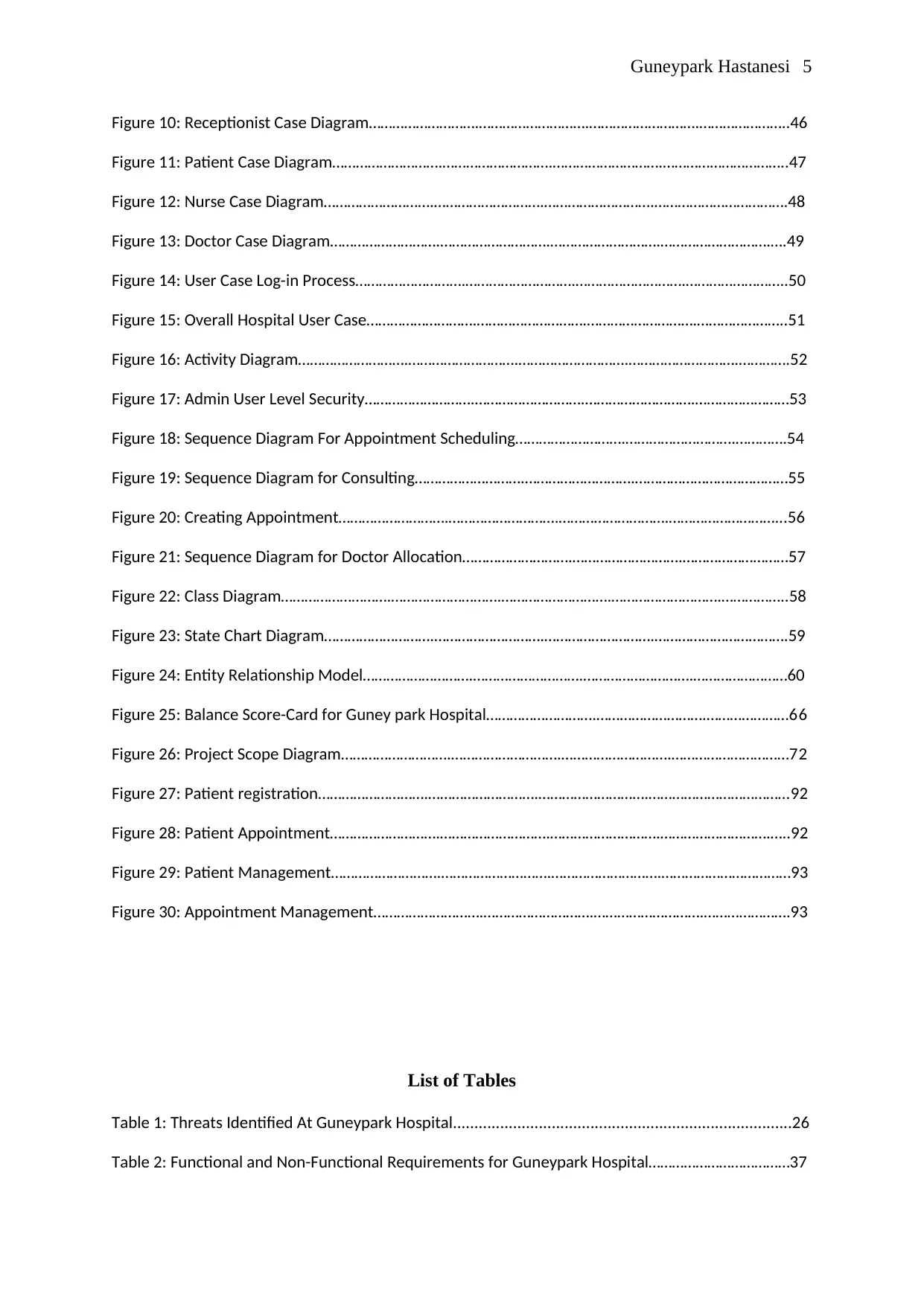
Guneypark Hastanesi 5
Figure 10: Receptionist Case Diagram……………………….……………………….……………………….…………………..46
Figure 11: Patient Case Diagram……………………….……………………….……………………….…………………………..47
Figure 12: Nurse Case Diagram……………………….……………………….……………………….…………………………….48
Figure 13: Doctor Case Diagram……………………….……………………….……………………….……………………….….49
Figure 14: User Case Log-in Process……………………….……………………….……………………….……………………..50
Figure 15: Overall Hospital User Case……………………….……………………….……………………….…………………..51
Figure 16: Activity Diagram……………………….……………………….……………………….……………………….………….52
Figure 17: Admin User Level Security……………………….……………………….……………………….……………………53
Figure 18: Sequence Diagram For Appointment Scheduling……………………….……………………….………….54
Figure 19: Sequence Diagram for Consulting……………………….……………………….…………………………………55
Figure 20: Creating Appointment……………………….……………………….……………………….………………………...56
Figure 21: Sequence Diagram for Doctor Allocation……………………….……………………….………………………57
Figure 22: Class Diagram……………………….……………………….……………………….……………………….……………..58
Figure 23: State Chart Diagram……………………….……………………….……………………….…………………………….59
Figure 24: Entity Relationship Model……………………….……………………….……………………….……………………60
Figure 25: Balance Score-Card for Guney park Hospital……………………….……………………….…………………66
Figure 26: Project Scope Diagram……………………….……………………….……………………….…………………………72
Figure 27: Patient registration……………………….……………………….……………………….………………………………92
Figure 28: Patient Appointment……………………….……………………….……………………….……………………….…..92
Figure 29: Patient Management……………………….……………………….……………………….……………………………93
Figure 30: Appointment Management……………………….……………………….……………………….………………….93
List of Tables
Table 1: Threats Identified At Guneypark Hospital...............................................................................26
Table 2: Functional and Non-Functional Requirements for Guneypark Hospital………………………………37
Figure 10: Receptionist Case Diagram……………………….……………………….……………………….…………………..46
Figure 11: Patient Case Diagram……………………….……………………….……………………….…………………………..47
Figure 12: Nurse Case Diagram……………………….……………………….……………………….…………………………….48
Figure 13: Doctor Case Diagram……………………….……………………….……………………….……………………….….49
Figure 14: User Case Log-in Process……………………….……………………….……………………….……………………..50
Figure 15: Overall Hospital User Case……………………….……………………….……………………….…………………..51
Figure 16: Activity Diagram……………………….……………………….……………………….……………………….………….52
Figure 17: Admin User Level Security……………………….……………………….……………………….……………………53
Figure 18: Sequence Diagram For Appointment Scheduling……………………….……………………….………….54
Figure 19: Sequence Diagram for Consulting……………………….……………………….…………………………………55
Figure 20: Creating Appointment……………………….……………………….……………………….………………………...56
Figure 21: Sequence Diagram for Doctor Allocation……………………….……………………….………………………57
Figure 22: Class Diagram……………………….……………………….……………………….……………………….……………..58
Figure 23: State Chart Diagram……………………….……………………….……………………….…………………………….59
Figure 24: Entity Relationship Model……………………….……………………….……………………….……………………60
Figure 25: Balance Score-Card for Guney park Hospital……………………….……………………….…………………66
Figure 26: Project Scope Diagram……………………….……………………….……………………….…………………………72
Figure 27: Patient registration……………………….……………………….……………………….………………………………92
Figure 28: Patient Appointment……………………….……………………….……………………….……………………….…..92
Figure 29: Patient Management……………………….……………………….……………………….……………………………93
Figure 30: Appointment Management……………………….……………………….……………………….………………….93
List of Tables
Table 1: Threats Identified At Guneypark Hospital...............................................................................26
Table 2: Functional and Non-Functional Requirements for Guneypark Hospital………………………………37
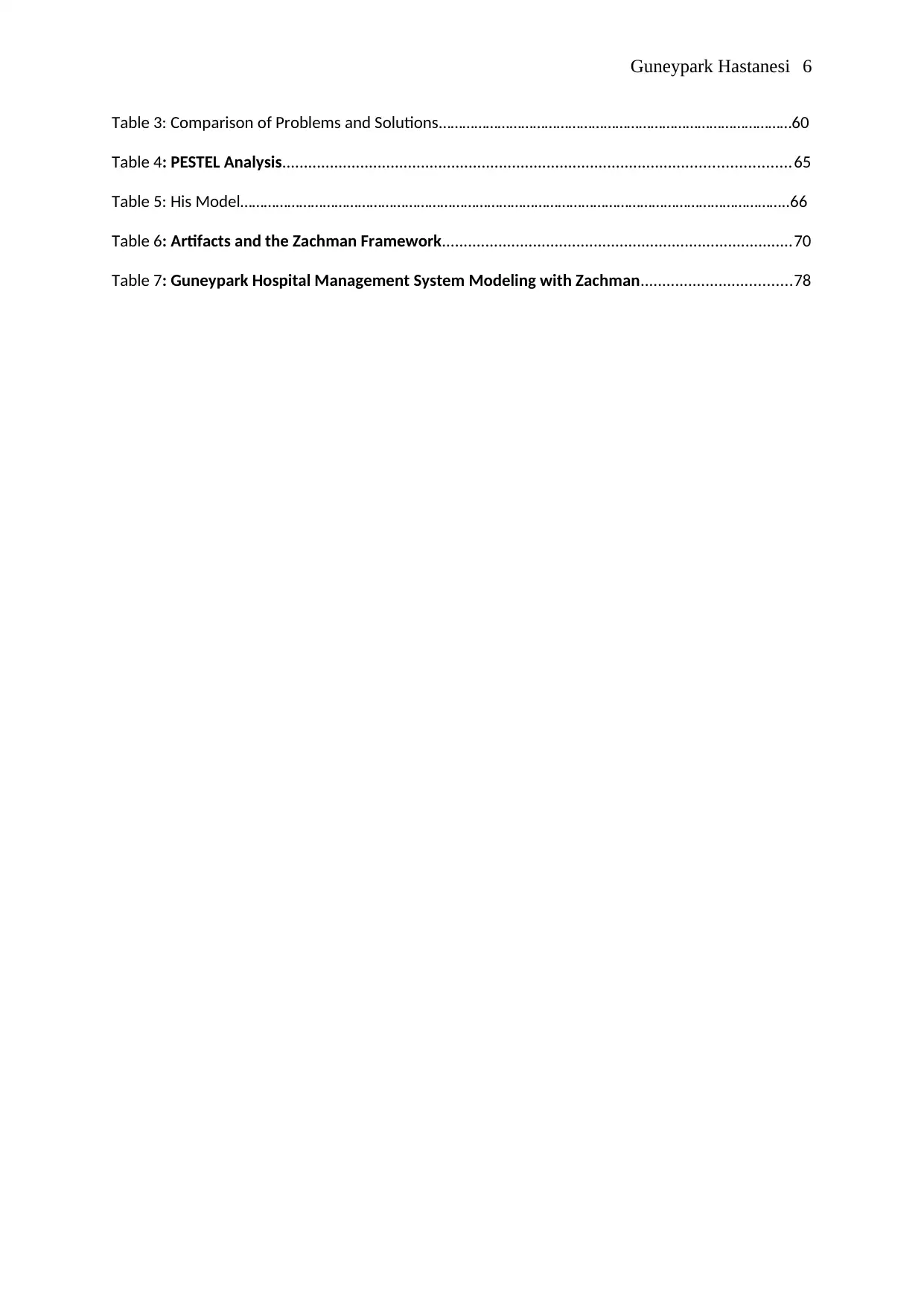
Guneypark Hastanesi 6
Table 3: Comparison of Problems and Solutions………………………………………………………………………………60
Table 4: PESTEL Analysis.....................................................................................................................65
Table 5: His Model…………………………………………………………………………………………………………………………..66
Table 6: Artifacts and the Zachman Framework.................................................................................70
Table 7: Guneypark Hospital Management System Modeling with Zachman...................................78
Table 3: Comparison of Problems and Solutions………………………………………………………………………………60
Table 4: PESTEL Analysis.....................................................................................................................65
Table 5: His Model…………………………………………………………………………………………………………………………..66
Table 6: Artifacts and the Zachman Framework.................................................................................70
Table 7: Guneypark Hospital Management System Modeling with Zachman...................................78
⊘ This is a preview!⊘
Do you want full access?
Subscribe today to unlock all pages.

Trusted by 1+ million students worldwide
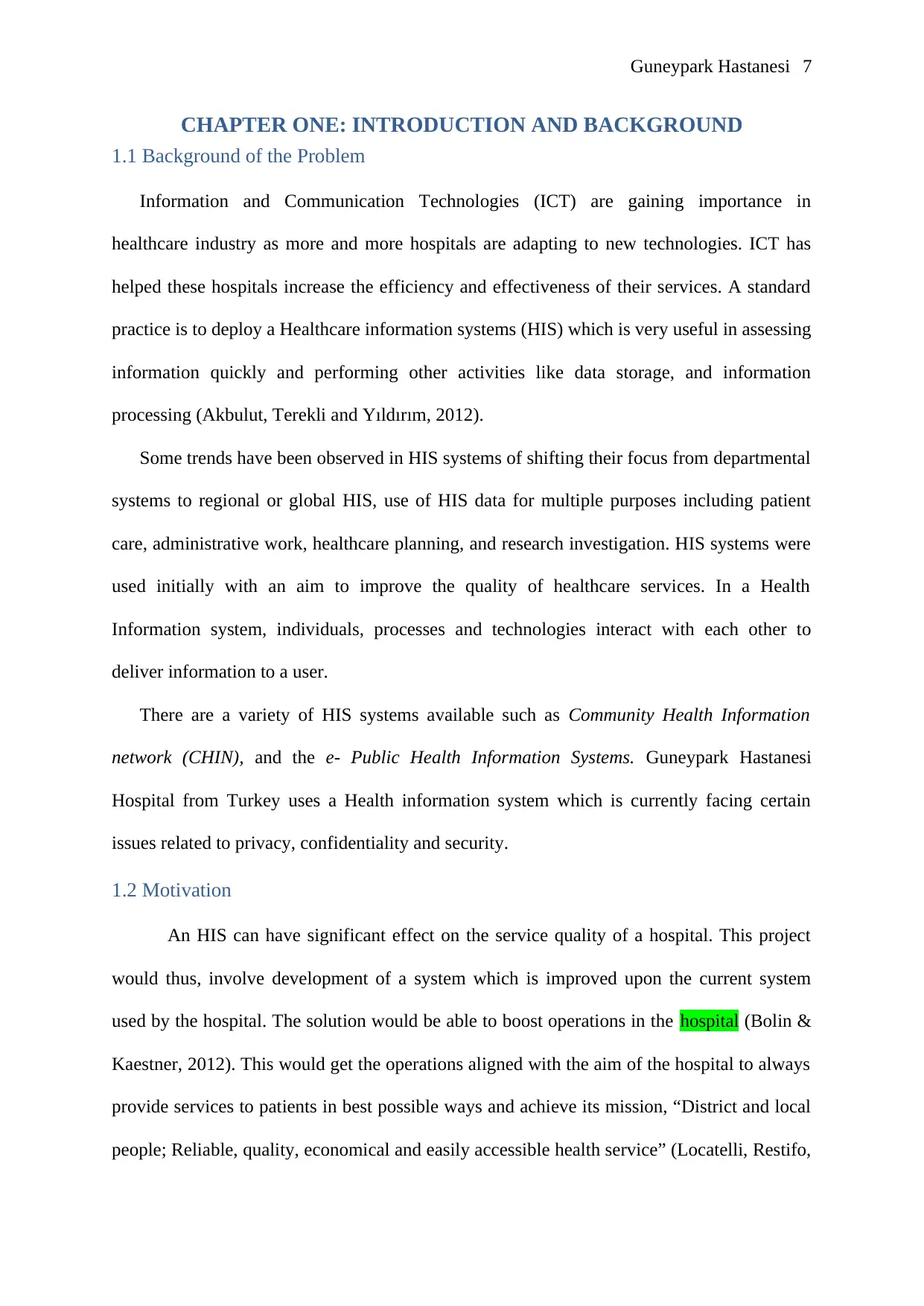
Guneypark Hastanesi 7
CHAPTER ONE: INTRODUCTION AND BACKGROUND
1.1 Background of the Problem
Information and Communication Technologies (ICT) are gaining importance in
healthcare industry as more and more hospitals are adapting to new technologies. ICT has
helped these hospitals increase the efficiency and effectiveness of their services. A standard
practice is to deploy a Healthcare information systems (HIS) which is very useful in assessing
information quickly and performing other activities like data storage, and information
processing (Akbulut, Terekli and Yıldırım, 2012).
Some trends have been observed in HIS systems of shifting their focus from departmental
systems to regional or global HIS, use of HIS data for multiple purposes including patient
care, administrative work, healthcare planning, and research investigation. HIS systems were
used initially with an aim to improve the quality of healthcare services. In a Health
Information system, individuals, processes and technologies interact with each other to
deliver information to a user.
There are a variety of HIS systems available such as Community Health Information
network (CHIN), and the e- Public Health Information Systems. Guneypark Hastanesi
Hospital from Turkey uses a Health information system which is currently facing certain
issues related to privacy, confidentiality and security.
1.2 Motivation
An HIS can have significant effect on the service quality of a hospital. This project
would thus, involve development of a system which is improved upon the current system
used by the hospital. The solution would be able to boost operations in the hospital (Bolin &
Kaestner, 2012). This would get the operations aligned with the aim of the hospital to always
provide services to patients in best possible ways and achieve its mission, “District and local
people; Reliable, quality, economical and easily accessible health service” (Locatelli, Restifo,
CHAPTER ONE: INTRODUCTION AND BACKGROUND
1.1 Background of the Problem
Information and Communication Technologies (ICT) are gaining importance in
healthcare industry as more and more hospitals are adapting to new technologies. ICT has
helped these hospitals increase the efficiency and effectiveness of their services. A standard
practice is to deploy a Healthcare information systems (HIS) which is very useful in assessing
information quickly and performing other activities like data storage, and information
processing (Akbulut, Terekli and Yıldırım, 2012).
Some trends have been observed in HIS systems of shifting their focus from departmental
systems to regional or global HIS, use of HIS data for multiple purposes including patient
care, administrative work, healthcare planning, and research investigation. HIS systems were
used initially with an aim to improve the quality of healthcare services. In a Health
Information system, individuals, processes and technologies interact with each other to
deliver information to a user.
There are a variety of HIS systems available such as Community Health Information
network (CHIN), and the e- Public Health Information Systems. Guneypark Hastanesi
Hospital from Turkey uses a Health information system which is currently facing certain
issues related to privacy, confidentiality and security.
1.2 Motivation
An HIS can have significant effect on the service quality of a hospital. This project
would thus, involve development of a system which is improved upon the current system
used by the hospital. The solution would be able to boost operations in the hospital (Bolin &
Kaestner, 2012). This would get the operations aligned with the aim of the hospital to always
provide services to patients in best possible ways and achieve its mission, “District and local
people; Reliable, quality, economical and easily accessible health service” (Locatelli, Restifo,
Paraphrase This Document
Need a fresh take? Get an instant paraphrase of this document with our AI Paraphraser
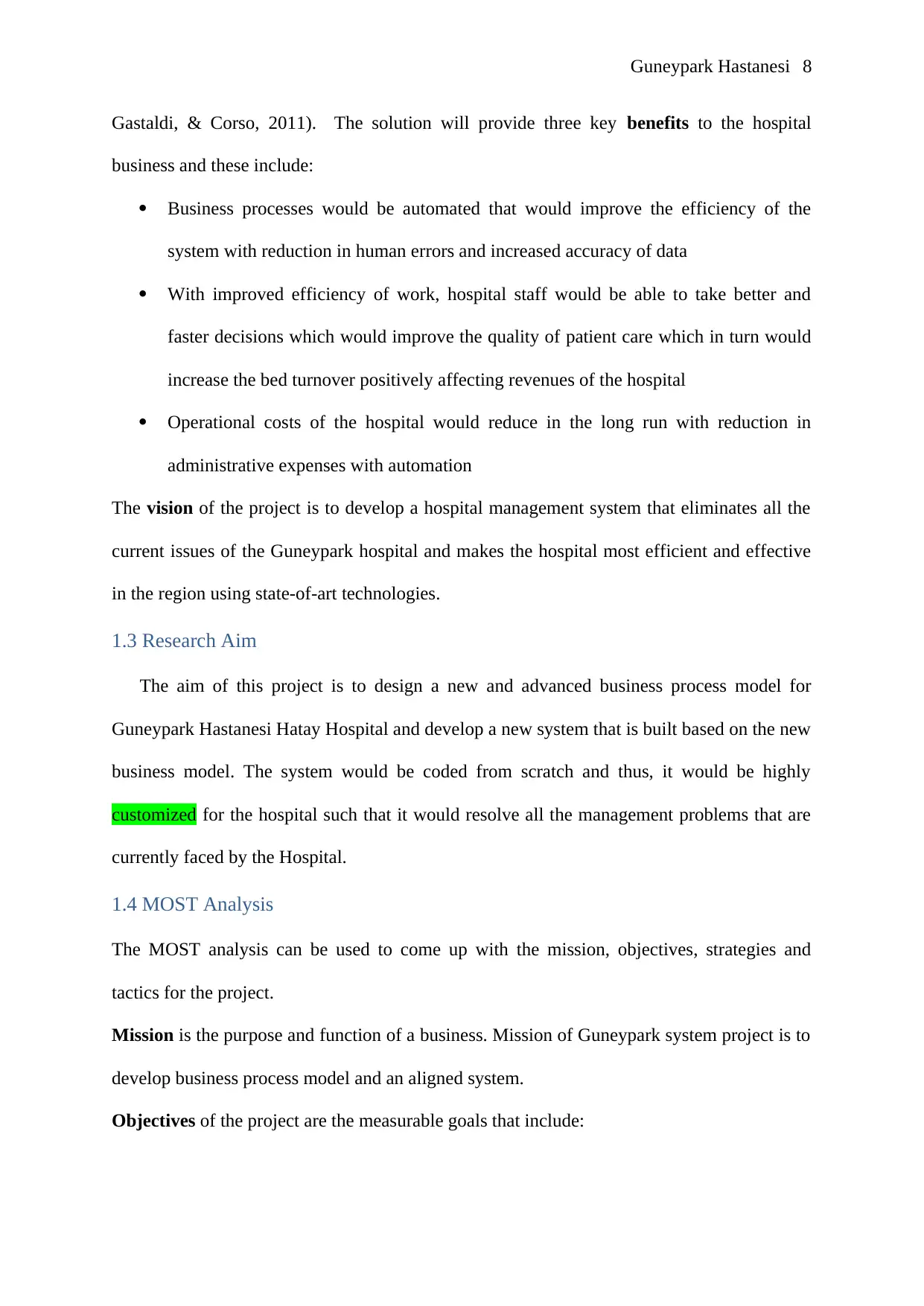
Guneypark Hastanesi 8
Gastaldi, & Corso, 2011). The solution will provide three key benefits to the hospital
business and these include:
Business processes would be automated that would improve the efficiency of the
system with reduction in human errors and increased accuracy of data
With improved efficiency of work, hospital staff would be able to take better and
faster decisions which would improve the quality of patient care which in turn would
increase the bed turnover positively affecting revenues of the hospital
Operational costs of the hospital would reduce in the long run with reduction in
administrative expenses with automation
The vision of the project is to develop a hospital management system that eliminates all the
current issues of the Guneypark hospital and makes the hospital most efficient and effective
in the region using state-of-art technologies.
1.3 Research Aim
The aim of this project is to design a new and advanced business process model for
Guneypark Hastanesi Hatay Hospital and develop a new system that is built based on the new
business model. The system would be coded from scratch and thus, it would be highly
customized for the hospital such that it would resolve all the management problems that are
currently faced by the Hospital.
1.4 MOST Analysis
The MOST analysis can be used to come up with the mission, objectives, strategies and
tactics for the project.
Mission is the purpose and function of a business. Mission of Guneypark system project is to
develop business process model and an aligned system.
Objectives of the project are the measurable goals that include:
Gastaldi, & Corso, 2011). The solution will provide three key benefits to the hospital
business and these include:
Business processes would be automated that would improve the efficiency of the
system with reduction in human errors and increased accuracy of data
With improved efficiency of work, hospital staff would be able to take better and
faster decisions which would improve the quality of patient care which in turn would
increase the bed turnover positively affecting revenues of the hospital
Operational costs of the hospital would reduce in the long run with reduction in
administrative expenses with automation
The vision of the project is to develop a hospital management system that eliminates all the
current issues of the Guneypark hospital and makes the hospital most efficient and effective
in the region using state-of-art technologies.
1.3 Research Aim
The aim of this project is to design a new and advanced business process model for
Guneypark Hastanesi Hatay Hospital and develop a new system that is built based on the new
business model. The system would be coded from scratch and thus, it would be highly
customized for the hospital such that it would resolve all the management problems that are
currently faced by the Hospital.
1.4 MOST Analysis
The MOST analysis can be used to come up with the mission, objectives, strategies and
tactics for the project.
Mission is the purpose and function of a business. Mission of Guneypark system project is to
develop business process model and an aligned system.
Objectives of the project are the measurable goals that include:
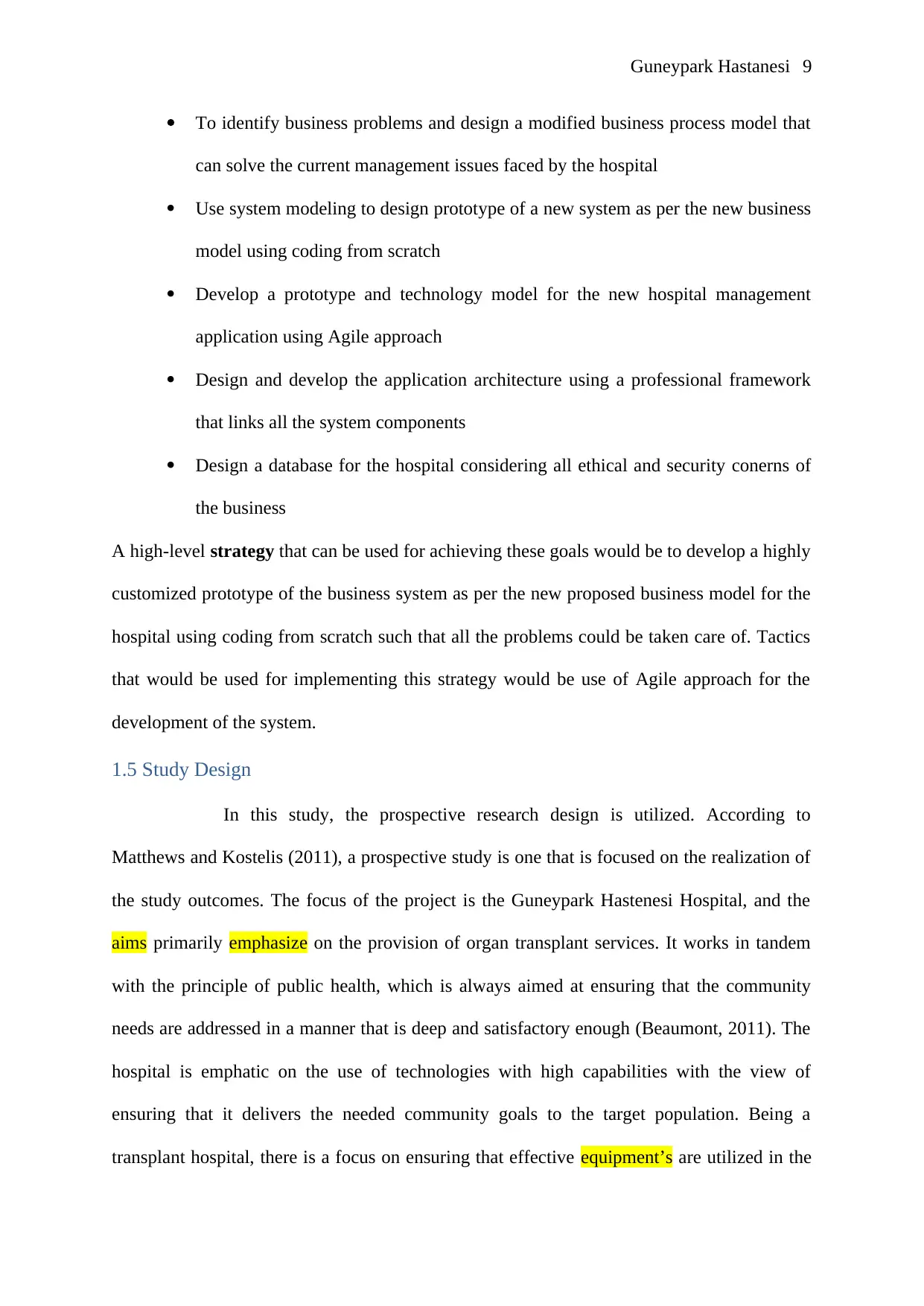
Guneypark Hastanesi 9
To identify business problems and design a modified business process model that
can solve the current management issues faced by the hospital
Use system modeling to design prototype of a new system as per the new business
model using coding from scratch
Develop a prototype and technology model for the new hospital management
application using Agile approach
Design and develop the application architecture using a professional framework
that links all the system components
Design a database for the hospital considering all ethical and security conerns of
the business
A high-level strategy that can be used for achieving these goals would be to develop a highly
customized prototype of the business system as per the new proposed business model for the
hospital using coding from scratch such that all the problems could be taken care of. Tactics
that would be used for implementing this strategy would be use of Agile approach for the
development of the system.
1.5 Study Design
In this study, the prospective research design is utilized. According to
Matthews and Kostelis (2011), a prospective study is one that is focused on the realization of
the study outcomes. The focus of the project is the Guneypark Hastenesi Hospital, and the
aims primarily emphasize on the provision of organ transplant services. It works in tandem
with the principle of public health, which is always aimed at ensuring that the community
needs are addressed in a manner that is deep and satisfactory enough (Beaumont, 2011). The
hospital is emphatic on the use of technologies with high capabilities with the view of
ensuring that it delivers the needed community goals to the target population. Being a
transplant hospital, there is a focus on ensuring that effective equipment’s are utilized in the
To identify business problems and design a modified business process model that
can solve the current management issues faced by the hospital
Use system modeling to design prototype of a new system as per the new business
model using coding from scratch
Develop a prototype and technology model for the new hospital management
application using Agile approach
Design and develop the application architecture using a professional framework
that links all the system components
Design a database for the hospital considering all ethical and security conerns of
the business
A high-level strategy that can be used for achieving these goals would be to develop a highly
customized prototype of the business system as per the new proposed business model for the
hospital using coding from scratch such that all the problems could be taken care of. Tactics
that would be used for implementing this strategy would be use of Agile approach for the
development of the system.
1.5 Study Design
In this study, the prospective research design is utilized. According to
Matthews and Kostelis (2011), a prospective study is one that is focused on the realization of
the study outcomes. The focus of the project is the Guneypark Hastenesi Hospital, and the
aims primarily emphasize on the provision of organ transplant services. It works in tandem
with the principle of public health, which is always aimed at ensuring that the community
needs are addressed in a manner that is deep and satisfactory enough (Beaumont, 2011). The
hospital is emphatic on the use of technologies with high capabilities with the view of
ensuring that it delivers the needed community goals to the target population. Being a
transplant hospital, there is a focus on ensuring that effective equipment’s are utilized in the
⊘ This is a preview!⊘
Do you want full access?
Subscribe today to unlock all pages.

Trusted by 1+ million students worldwide
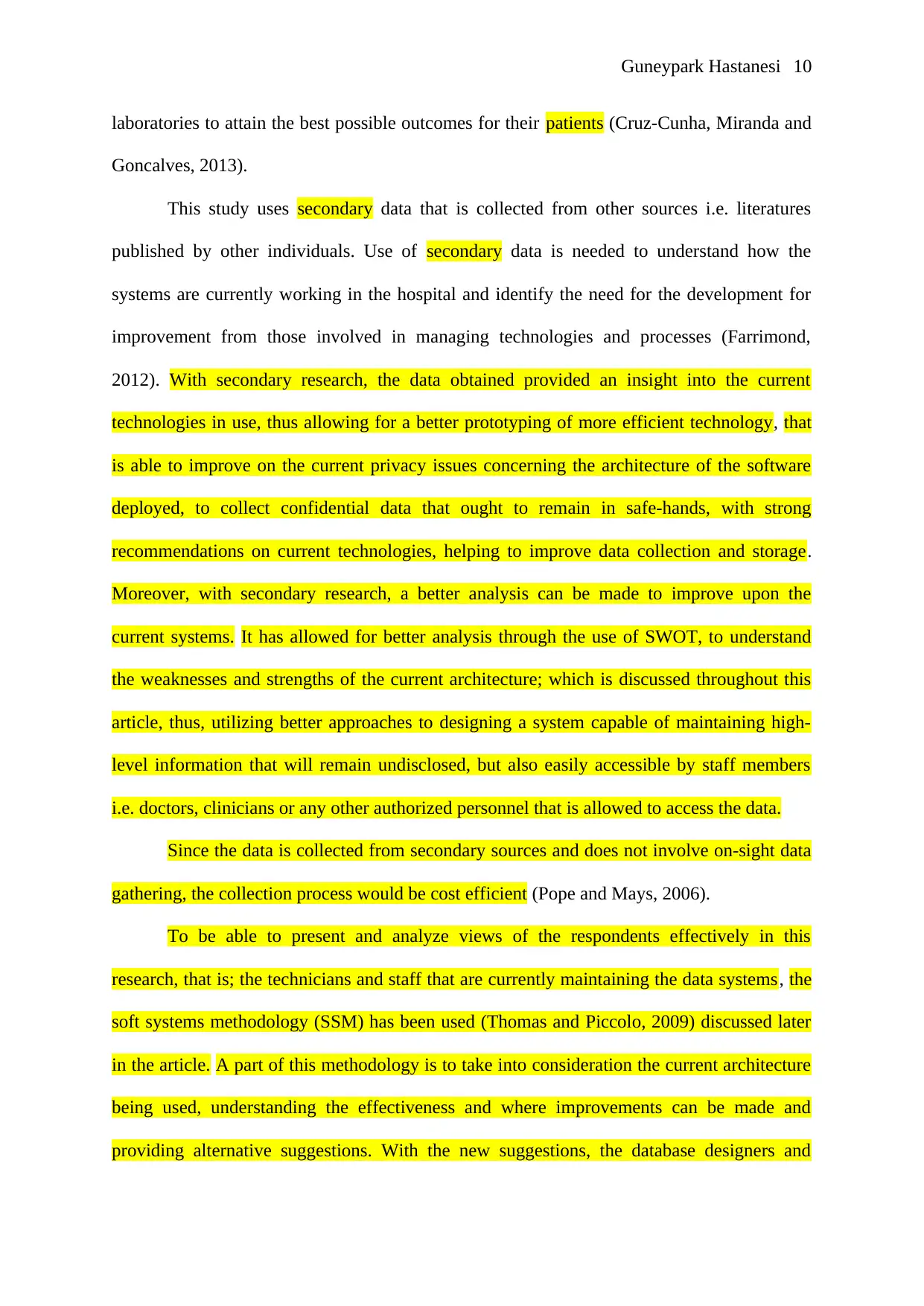
Guneypark Hastanesi 10
laboratories to attain the best possible outcomes for their patients (Cruz-Cunha, Miranda and
Goncalves, 2013).
This study uses secondary data that is collected from other sources i.e. literatures
published by other individuals. Use of secondary data is needed to understand how the
systems are currently working in the hospital and identify the need for the development for
improvement from those involved in managing technologies and processes (Farrimond,
2012). With secondary research, the data obtained provided an insight into the current
technologies in use, thus allowing for a better prototyping of more efficient technology, that
is able to improve on the current privacy issues concerning the architecture of the software
deployed, to collect confidential data that ought to remain in safe-hands, with strong
recommendations on current technologies, helping to improve data collection and storage.
Moreover, with secondary research, a better analysis can be made to improve upon the
current systems. It has allowed for better analysis through the use of SWOT, to understand
the weaknesses and strengths of the current architecture; which is discussed throughout this
article, thus, utilizing better approaches to designing a system capable of maintaining high-
level information that will remain undisclosed, but also easily accessible by staff members
i.e. doctors, clinicians or any other authorized personnel that is allowed to access the data.
Since the data is collected from secondary sources and does not involve on-sight data
gathering, the collection process would be cost efficient (Pope and Mays, 2006).
To be able to present and analyze views of the respondents effectively in this
research, that is; the technicians and staff that are currently maintaining the data systems, the
soft systems methodology (SSM) has been used (Thomas and Piccolo, 2009) discussed later
in the article. A part of this methodology is to take into consideration the current architecture
being used, understanding the effectiveness and where improvements can be made and
providing alternative suggestions. With the new suggestions, the database designers and
laboratories to attain the best possible outcomes for their patients (Cruz-Cunha, Miranda and
Goncalves, 2013).
This study uses secondary data that is collected from other sources i.e. literatures
published by other individuals. Use of secondary data is needed to understand how the
systems are currently working in the hospital and identify the need for the development for
improvement from those involved in managing technologies and processes (Farrimond,
2012). With secondary research, the data obtained provided an insight into the current
technologies in use, thus allowing for a better prototyping of more efficient technology, that
is able to improve on the current privacy issues concerning the architecture of the software
deployed, to collect confidential data that ought to remain in safe-hands, with strong
recommendations on current technologies, helping to improve data collection and storage.
Moreover, with secondary research, a better analysis can be made to improve upon the
current systems. It has allowed for better analysis through the use of SWOT, to understand
the weaknesses and strengths of the current architecture; which is discussed throughout this
article, thus, utilizing better approaches to designing a system capable of maintaining high-
level information that will remain undisclosed, but also easily accessible by staff members
i.e. doctors, clinicians or any other authorized personnel that is allowed to access the data.
Since the data is collected from secondary sources and does not involve on-sight data
gathering, the collection process would be cost efficient (Pope and Mays, 2006).
To be able to present and analyze views of the respondents effectively in this
research, that is; the technicians and staff that are currently maintaining the data systems, the
soft systems methodology (SSM) has been used (Thomas and Piccolo, 2009) discussed later
in the article. A part of this methodology is to take into consideration the current architecture
being used, understanding the effectiveness and where improvements can be made and
providing alternative suggestions. With the new suggestions, the database designers and
Paraphrase This Document
Need a fresh take? Get an instant paraphrase of this document with our AI Paraphraser
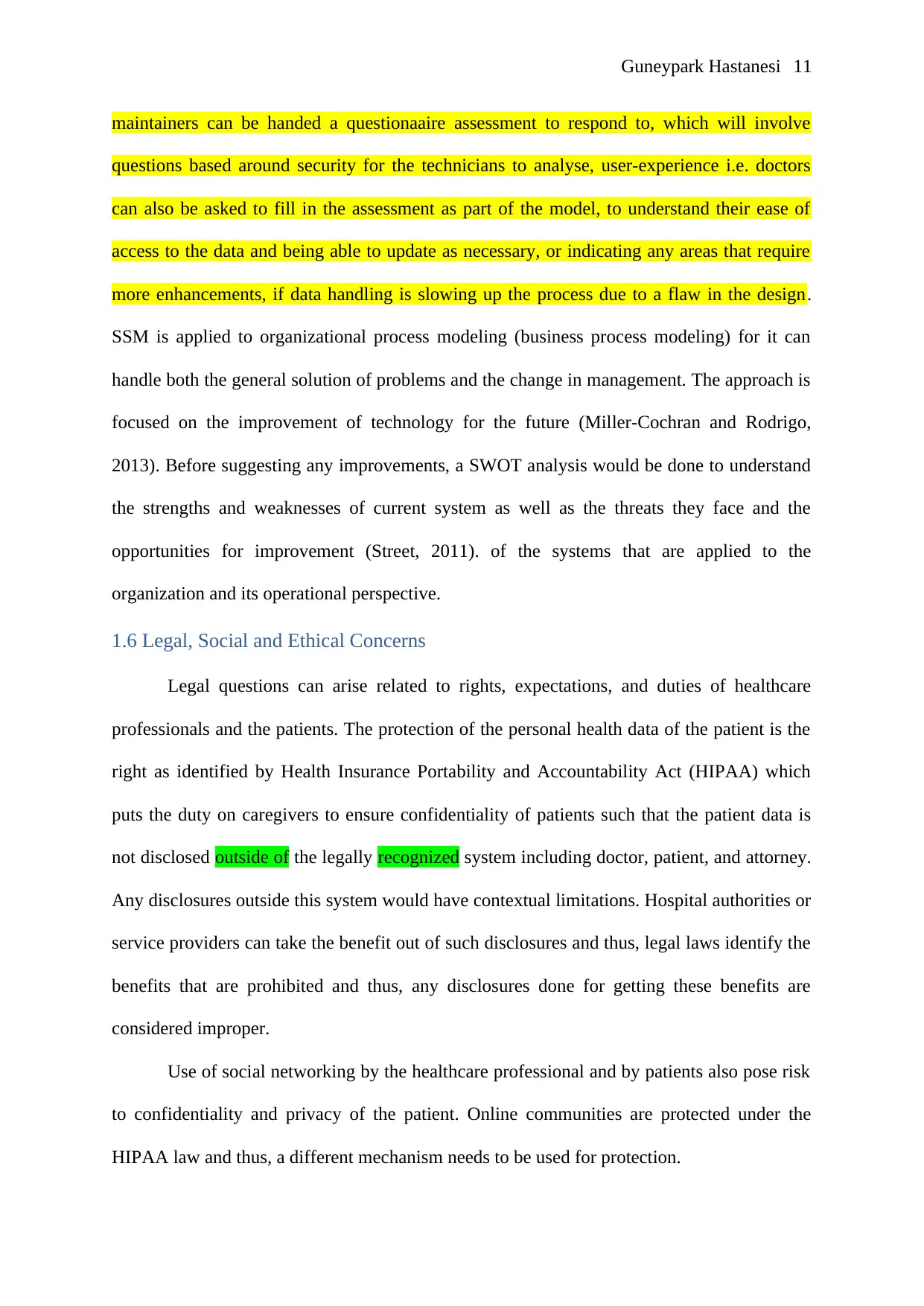
Guneypark Hastanesi 11
maintainers can be handed a questionaaire assessment to respond to, which will involve
questions based around security for the technicians to analyse, user-experience i.e. doctors
can also be asked to fill in the assessment as part of the model, to understand their ease of
access to the data and being able to update as necessary, or indicating any areas that require
more enhancements, if data handling is slowing up the process due to a flaw in the design.
SSM is applied to organizational process modeling (business process modeling) for it can
handle both the general solution of problems and the change in management. The approach is
focused on the improvement of technology for the future (Miller-Cochran and Rodrigo,
2013). Before suggesting any improvements, a SWOT analysis would be done to understand
the strengths and weaknesses of current system as well as the threats they face and the
opportunities for improvement (Street, 2011). of the systems that are applied to the
organization and its operational perspective.
1.6 Legal, Social and Ethical Concerns
Legal questions can arise related to rights, expectations, and duties of healthcare
professionals and the patients. The protection of the personal health data of the patient is the
right as identified by Health Insurance Portability and Accountability Act (HIPAA) which
puts the duty on caregivers to ensure confidentiality of patients such that the patient data is
not disclosed outside of the legally recognized system including doctor, patient, and attorney.
Any disclosures outside this system would have contextual limitations. Hospital authorities or
service providers can take the benefit out of such disclosures and thus, legal laws identify the
benefits that are prohibited and thus, any disclosures done for getting these benefits are
considered improper.
Use of social networking by the healthcare professional and by patients also pose risk
to confidentiality and privacy of the patient. Online communities are protected under the
HIPAA law and thus, a different mechanism needs to be used for protection.
maintainers can be handed a questionaaire assessment to respond to, which will involve
questions based around security for the technicians to analyse, user-experience i.e. doctors
can also be asked to fill in the assessment as part of the model, to understand their ease of
access to the data and being able to update as necessary, or indicating any areas that require
more enhancements, if data handling is slowing up the process due to a flaw in the design.
SSM is applied to organizational process modeling (business process modeling) for it can
handle both the general solution of problems and the change in management. The approach is
focused on the improvement of technology for the future (Miller-Cochran and Rodrigo,
2013). Before suggesting any improvements, a SWOT analysis would be done to understand
the strengths and weaknesses of current system as well as the threats they face and the
opportunities for improvement (Street, 2011). of the systems that are applied to the
organization and its operational perspective.
1.6 Legal, Social and Ethical Concerns
Legal questions can arise related to rights, expectations, and duties of healthcare
professionals and the patients. The protection of the personal health data of the patient is the
right as identified by Health Insurance Portability and Accountability Act (HIPAA) which
puts the duty on caregivers to ensure confidentiality of patients such that the patient data is
not disclosed outside of the legally recognized system including doctor, patient, and attorney.
Any disclosures outside this system would have contextual limitations. Hospital authorities or
service providers can take the benefit out of such disclosures and thus, legal laws identify the
benefits that are prohibited and thus, any disclosures done for getting these benefits are
considered improper.
Use of social networking by the healthcare professional and by patients also pose risk
to confidentiality and privacy of the patient. Online communities are protected under the
HIPAA law and thus, a different mechanism needs to be used for protection.
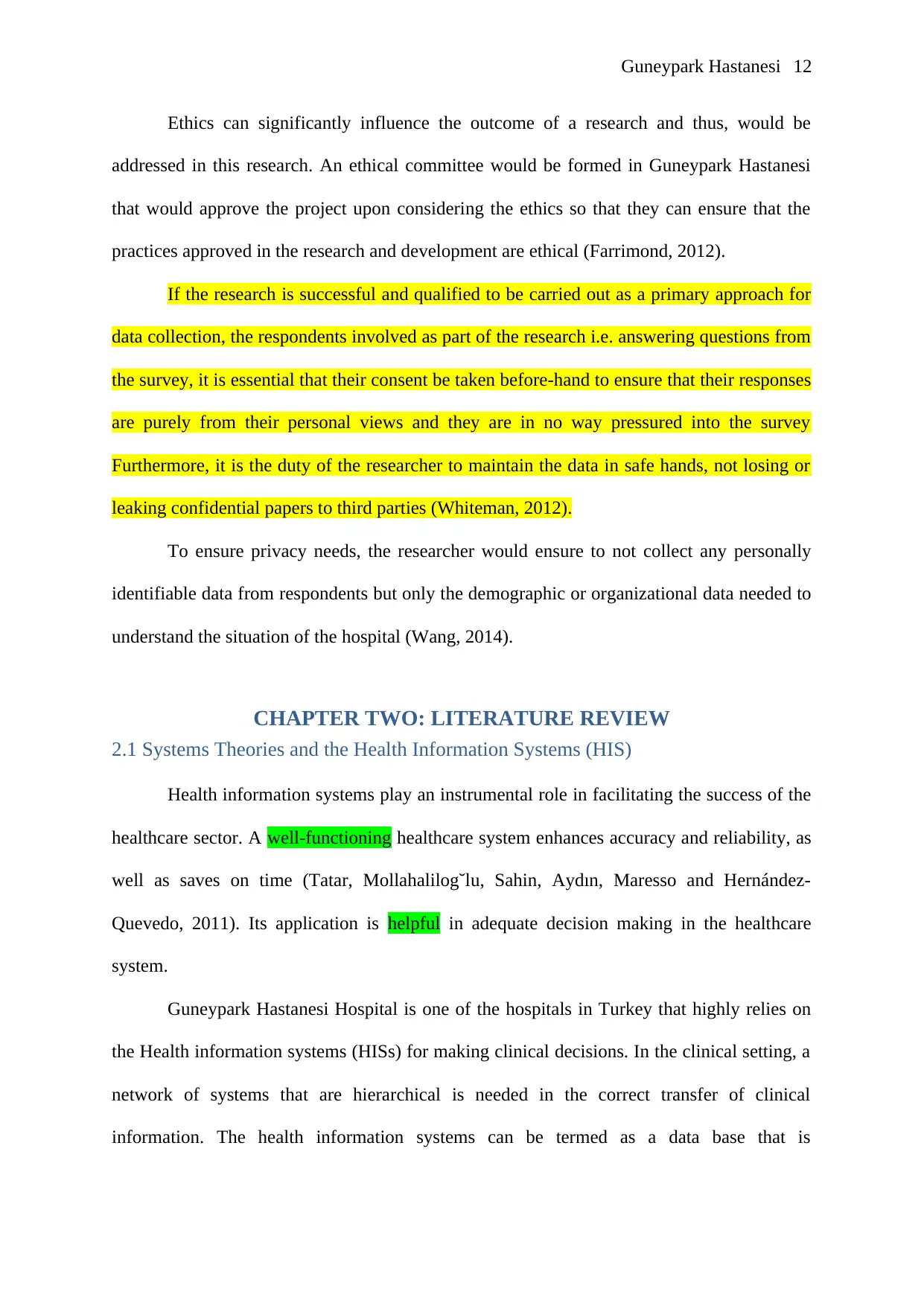
Guneypark Hastanesi 12
Ethics can significantly influence the outcome of a research and thus, would be
addressed in this research. An ethical committee would be formed in Guneypark Hastanesi
that would approve the project upon considering the ethics so that they can ensure that the
practices approved in the research and development are ethical (Farrimond, 2012).
If the research is successful and qualified to be carried out as a primary approach for
data collection, the respondents involved as part of the research i.e. answering questions from
the survey, it is essential that their consent be taken before-hand to ensure that their responses
are purely from their personal views and they are in no way pressured into the survey
Furthermore, it is the duty of the researcher to maintain the data in safe hands, not losing or
leaking confidential papers to third parties (Whiteman, 2012).
To ensure privacy needs, the researcher would ensure to not collect any personally
identifiable data from respondents but only the demographic or organizational data needed to
understand the situation of the hospital (Wang, 2014).
CHAPTER TWO: LITERATURE REVIEW
2.1 Systems Theories and the Health Information Systems (HIS)
Health information systems play an instrumental role in facilitating the success of the
healthcare sector. A well-functioning healthcare system enhances accuracy and reliability, as
well as saves on time (Tatar, Mollahalilog˘lu, Sahin, Aydın, Maresso and Hernández-
Quevedo, 2011). Its application is helpful in adequate decision making in the healthcare
system.
Guneypark Hastanesi Hospital is one of the hospitals in Turkey that highly relies on
the Health information systems (HISs) for making clinical decisions. In the clinical setting, a
network of systems that are hierarchical is needed in the correct transfer of clinical
information. The health information systems can be termed as a data base that is
Ethics can significantly influence the outcome of a research and thus, would be
addressed in this research. An ethical committee would be formed in Guneypark Hastanesi
that would approve the project upon considering the ethics so that they can ensure that the
practices approved in the research and development are ethical (Farrimond, 2012).
If the research is successful and qualified to be carried out as a primary approach for
data collection, the respondents involved as part of the research i.e. answering questions from
the survey, it is essential that their consent be taken before-hand to ensure that their responses
are purely from their personal views and they are in no way pressured into the survey
Furthermore, it is the duty of the researcher to maintain the data in safe hands, not losing or
leaking confidential papers to third parties (Whiteman, 2012).
To ensure privacy needs, the researcher would ensure to not collect any personally
identifiable data from respondents but only the demographic or organizational data needed to
understand the situation of the hospital (Wang, 2014).
CHAPTER TWO: LITERATURE REVIEW
2.1 Systems Theories and the Health Information Systems (HIS)
Health information systems play an instrumental role in facilitating the success of the
healthcare sector. A well-functioning healthcare system enhances accuracy and reliability, as
well as saves on time (Tatar, Mollahalilog˘lu, Sahin, Aydın, Maresso and Hernández-
Quevedo, 2011). Its application is helpful in adequate decision making in the healthcare
system.
Guneypark Hastanesi Hospital is one of the hospitals in Turkey that highly relies on
the Health information systems (HISs) for making clinical decisions. In the clinical setting, a
network of systems that are hierarchical is needed in the correct transfer of clinical
information. The health information systems can be termed as a data base that is
⊘ This is a preview!⊘
Do you want full access?
Subscribe today to unlock all pages.

Trusted by 1+ million students worldwide
1 out of 108
Related Documents
Your All-in-One AI-Powered Toolkit for Academic Success.
+13062052269
info@desklib.com
Available 24*7 on WhatsApp / Email
![[object Object]](/_next/static/media/star-bottom.7253800d.svg)
Unlock your academic potential
Copyright © 2020–2025 A2Z Services. All Rights Reserved. Developed and managed by ZUCOL.




